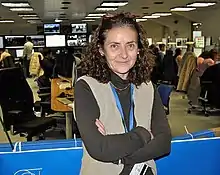Teresa Rodrigo
Teresa Rodrigo Anoro (1956 – 21 April 2020) was a Spanish scientist who worked in particle physics. She worked at CERN, Fermilab and the Instituto de Física de Cantabria and was professor at the University of Cantabria. Whilst at CERN, Rodrigo worked on the Compact Muon Solenoid and research for the Higgs boson.
Teresa Rodrigo | |
|---|---|
 Rodrigo at CERN's Compact Muon Solenoid facility in 2010. | |
| Born | Teresa Rodrigo Anoro 1956 Lleida, Spain |
| Died | 21 April 2020 (aged 63–64) |
| Nationality | Spanish |
| Alma mater |
|
| Scientific career | |
| Fields | |
| Institutions | |
Career
In 1994, Rodrigo became a professor of atomic physics at the University of Cantabria.[1] Rodrigo also worked at the Instituto de Física de Cantabria (IFCA) and Fermilab in the US.[2] She worked on the Collider Detector at Fermilab experiment that discovered the top quark in 1995.[1][3][4][5]
Rodrigo worked on Higgs boson research, and collaborated with CERN.[2][6] She was the first Spanish female scientist to work at CERN,[2] and worked on the UA1 experiment,[7][8] and from 1994, she worked on the Compact Muon Solenoid (CMS) at the Large Hadron Collider in CERN.[2][9][10] She managed a team of 30 IFCA employees on the CMS project,[1] and managed one of the teams that worked on proving the existence of the Higgs boson.[3][11][12] In 2010, she became president of CERN's International Collaboration Council,[1] making her the first Spanish physicist to be part of the International Collaboration Council.[3]
From 2016 to 2019, Rodrigo was a director of IFCA.[2] She was the sixth director of IFCA, and the first female director.[13] Rodrigo also collaborated on the European Strategy for Particle Physics.[14]
Awards
In 2014, Rodrigo was named one of the 100 most influential women in Spain by website Mujeresycia.com.[15] In 2016, Rodrigo received the Julio Peláez Prize for Pioneers of Physical, Chemical and Mathematical Sciences for her work on the discovery of the Higgs boson.[16]
Personal life
Rodrigo was born in Lleida, Spain.[2] She studied at the University of Zaragoza, and earned a PhD from La Junta de Energía Nuclear (now CIEMAT).[7][14]
Rodrigo died on 21 April 2020 in Santander, Spain.[2]
References
- "Muere Teresa Rodrigo, la 'madre española' del bosón de Higgs". El Español (in Spanish). 21 April 2020. Retrieved 7 December 2020.
- "Fallece Teresa Rodrigo, científica pionera y experta mundial en física de partículas". El Diario Montañés (in Spanish). 21 April 2020. Retrieved 7 December 2020.
- "Muere Teresa Rodrigo, una de las físicas españolas más relevantes y que formó parte del proyecto del Bosón de Higgs". 20 minutos (in Spanish). 21 April 2020. Retrieved 8 December 2020.
- Cabrera, S; Fernández, J; Gómez, G; Piedra, J; Rodrigo, T; Ruiz, A; Vila, I; Vilar, R; Grozis, C; Kephart, R; Stanek, R (2002). "The CDF-II time-of-flight detector". Nuclear Instruments and Methods in Physics Research Section A: Accelerators, Spectrometers, Detectors and Associated Equipment. 494 (1–3): 416–423. Bibcode:2002NIMPA.494..416C. doi:10.1016/S0168-9002(02)01512-7.
- CDF Collaboration; Abulencia, A.; Acosta, D.; Adelman, J.; Affolder, T.; Akimoto, T.; Albrow, M. G.; Ambrose, D.; Amerio, S.; Amidei, D.; Anastassov, A. (25 August 2006). "Measurement of the t Production Cross Section in pp Collisions at √s=1.96 TeV". Physical Review Letters. 97 (8): 082004. arXiv:hep-ex/0606017. doi:10.1103/PhysRevLett.97.082004. hdl:1969.1/181538. PMID 17026295. S2CID 118993472.
- Casas, Alberto; Rodrigo, Teresa (2012). El bosón de Higgs (in Spanish). Madrid: Consejo Superior de Investigaciones Científicas. ISBN 978-84-00-09606-9. OCLC 828121951.
- "Teresa Rodrigo Anoro (1956–2020)". CERN. 29 April 2020. Retrieved 7 December 2020.
- UA1 Collaboration; Albajar, C.; Albrow, M. G.; Allkofer, O. C.; Arnison, G.; Astbury, A.; Aubert, B.; Axon, T.; Bacci, C.; Bacon, T.; Bains, N. (1989). "Studies of intermediate vector boson production and decay in UA1 at the CERN proton-antiproton collider". Zeitschrift für Physik C. 44 (1): 15–61. doi:10.1007/BF01548582. ISSN 0170-9739. S2CID 123959490.
- "Teresa Rodrigo, nueva directora del Instituto de Física de Cantabria" (in Spanish). Instituto de Física de Cantabria. 8 April 2016. Retrieved 8 December 2020.
- The CMS collaboration (4 November 2013). "The performance of the CMS muon detector in proton-proton collisions at √s = 7 TeV at the LHC". Journal of Instrumentation. 8 (11): P11002. arXiv:1306.6905. Bibcode:2013JInst...8P1002T. doi:10.1088/1748-0221/8/11/P11002. ISSN 1748-0221. S2CID 118837054.
- Chatrchyan, S.; Khachatryan, V.; Sirunyan, A.M.; Tumasyan, A.; Adam, W.; Aguilo, E.; Bergauer, T.; Dragicevic, M.; Erö, J.; Fabjan, C.; Friedl, M. (2012). "Observation of a new boson at a mass of 125 GeV with the CMS experiment at the LHC". Physics Letters B. 716 (1): 30–61. arXiv:1207.7235. Bibcode:2012PhLB..716...30C. doi:10.1016/j.physletb.2012.08.021.
- Chatrchyan, S.; Khachatryan, V.; Sirunyan, A.M.; Tumasyan, A.; Adam, W.; Bergauer, T.; Dragicevic, M.; Erö, J.; Fabjan, C.; Friedl, M.; Frühwirth, R. (2012). "Combined results of searches for the standard model Higgs boson in pp collisions at s=7 TeV". Physics Letters B. 710 (1): 26–48. doi:10.1016/j.physletb.2012.02.064.
- "Teresa Rodrigo, nueva directora del Instituto de Física de Cantabria". El Gallo (in Spanish). 2016. Retrieved 7 December 2020.
- "Teresa Rodrigo, un referente de la ciencia española". El País (in Spanish). 24 April 2020. Retrieved 7 December 2020.
- "Muere Teresa Rodrigo, científica, Top 100 y "madre española" del bosón de Higgs" (in Spanish). Mujeresycia.com. 27 April 2020. Retrieved 7 December 2020.
- "Teresa Rodrigo recibe el "Premio Julio Peláez a Pioneras de las Ciencias Físicas, Químicas y Matemáticas" que otorga la fundación" (in Spanish). Fundación Tatiana Pérez de Guzmán el Bueno. 8 September 2016. Retrieved 7 December 2020.